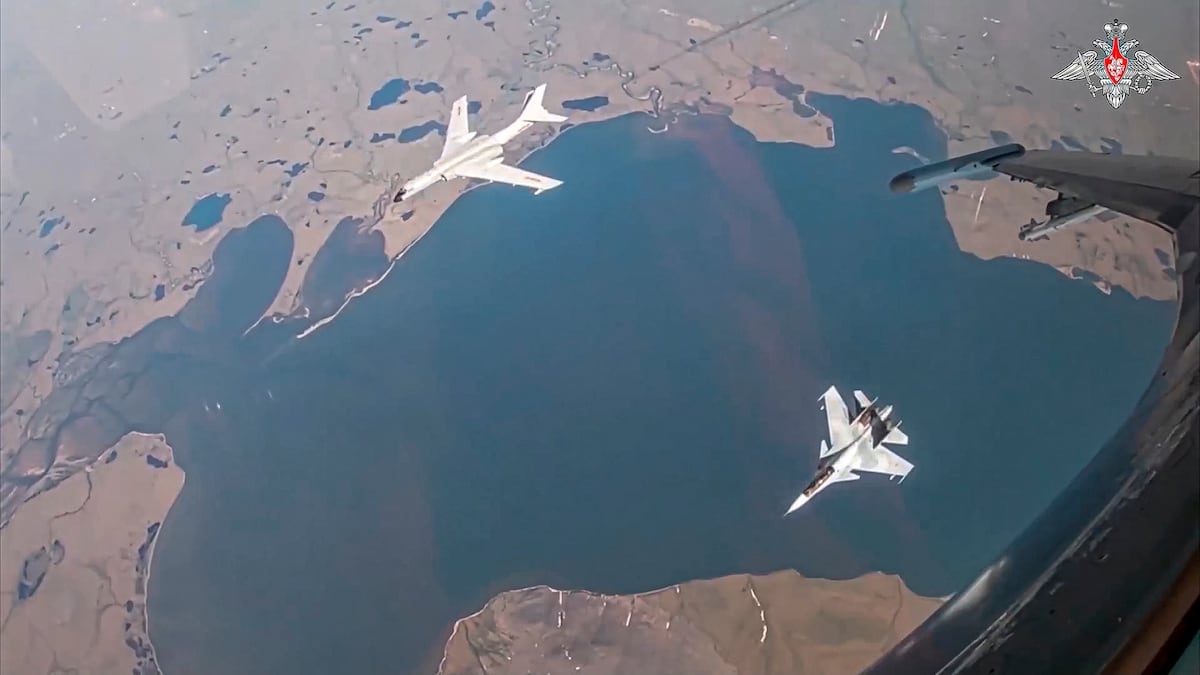Deploying military forces is the strongest of political signals, and the most potent of these deployments is to move nuclear weapons or launch platforms near a potential adversary.
So when nuclear-capable Chinese bombers joined their Russian counterparts in joint patrols near Alaska in 2024, as well as similar flights deep into the Pacific, Western observers assumed there was a political message. Russia had been conducting such provocative flights dating back to the Cold War, but this is something new for China. Was Beijing signaling its displeasure with America over Taiwan, or warning NATO not to get involved in Asia? Was invoking the specter of Chinese bombers over America a reminder that the vast Pacific was no barrier to the long arm of Chinese power?
However, China may have had other motives for these flights, according to a U.S. expert. Beijing may have been demonstrating that nuclear bombers were now a fully functional part of its strategic triad, alongside ICBMs and ballistic missile submarines.
“It is clear that their true significance lies in China’s years-long effort to complete its nuclear triad,” Derek Solen, a researcher at the U.S. Air Force’s China Aerospace Studies Institute, wrote in a report for the Japan Air Self-Defense Force’s Air and Space Studies Institute.
Another possibility is that the flights were intended as a warning to the U.S. not to engage in “nuclear sharing,” in which America would station nuclear weapons in non-nuclear allies, especially Japan and South Korea. “China probably fears that the limited exchange between NATO and America’s Asian allies will eventually lead to the integration of America’s European and Asian alliance networks, resulting in the formation of a global, nuclear-armed anti-China alliance,” Solen wrote.
Deciphering Beijing’s intentions behind the bomber missions isn’t easy. There have been just nine Sino-Russian flights since the first mission in 2019, when two Chinese H-6K and two Russian Tu-95MS bombers flew over the Sea of Japan and East China Sea. Though the actual number of flights is somewhat larger — China counts multiple flights on the same day as a single flight — this leaves a small dataset to analyze.
The joint flights were mostly confined to the Sea of Japan and East China Sea until July 24, 2024, when two H-6Ks and two Tu-95s flew near Alaska. Though they didn’t penetrate U.S. airspace, they did enter the air defense identification zone, triggering interception by U.S. and Canadian fighters.
“This represented the first time that PLAAF [People’s Liberation Army Air Force] aircraft participating in a combined patrol sortied from a foreign country as well as the first time that PLAAF aircraft approached U.S. territory,” Solen noted.
A few days later came more joint flights over the Sea of Japan, East China Sea and Western Pacific, which included more advanced H-6N bombers from the 106th Brigade in Henan province, which is primarily tasked with delivering nuclear weapons. The H-6N has a range of 3,700 miles and can launch KD-21 air-launched cruise missiles with an estimated range of up to 1,300 miles. Particularly ominous was a Nov. 30, 2024, flight in which H-6Ns came within cruise missile range of Guam in what Solen believes may have been “the first serious training to conduct a nuclear strike against Guam from the air.”
Solen told Defense News that he initially believed that the flights were a political signal.
“I thought that Beijing was signaling two things simultaneously,” he said. “It was signaling that its relationship with Russia was tight and, by using the H-6, sending an indirect message to Washington that it possesses the means and the will to counter what it perceived as Washington’s moves with respect to nuclear sharing.”
But Solen was troubled by some inconsistencies. For example, the Chinese government was incensed by a July 2024 NATO summit that criticized China for supporting Russia’s invasion of Ukraine, as well as suggestions that NATO might expand its focus to Asia. Yet if the November 2024 flights near Guam were intended as a signal, then why wait until four months after the summit?
The joint flights also coincided with the deployment of the long-range and nuclear-capable H-6N.
“In 2019 the PLAAF officially adopted the H-6N, and in the same year renovations to the 106th Brigade’s base were likely finished,” Solen wrote. “It is interesting that the Sino-Russian combined patrols began that same year.”
Of course, the Alaska flights may have both a military and political purpose. However, Solen thinks that purely military training flights would have been confined to the East China Sea or the Sea of Japan.
Perhaps the West may never know China’s true motivations. Nonetheless, the question remains: Will China again send bombers near — or into — American airspace? China continues to be an indispensable supplier of Russia’s campaign in Ukraine, and the Chinese and Russian navies have just announced joint patrols in the Pacific. A Chinese government spokesman last year urged “relevant countries to abolish the nuclear sharing arrangement, withdraw the large number of nuclear weapons deployed in Europe, and refrain from replicating such arrangements in any form in the Asia-Pacific region.”
For now, China isn’t provoking the Trump administration, especially in the midst of a fight over tariffs.
“The fact that China and Russia still haven’t done any combined flights this year is probably a political decision,” Solen said. “At a time when they are trying to work things out with the new administration, they probably decided that it’s best to avoid action that may agitate Washington or distract from the agenda in the negotiations.”
Regular flights near U.S. territory are unlikely “because the training juice won’t be worth the squeeze,” Solen added. On the other hand, China has an incentive to practice long-range bomber flights, even just for non-nuclear missions like striking ships and bases.
“I suppose that once they’ve either resolved things with Washington or just given up on negotiations, we’ll see the combined flights resume and eventually see regular flights without the Russians,” Solen said.
Read the full article here





